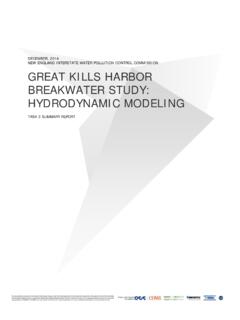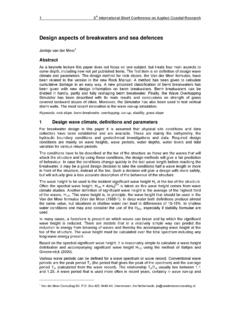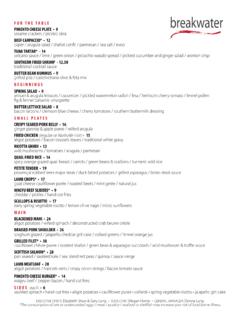Transcription of GREAT KILLS HARBOR BREAKWATER STUDY: APPROACHES …
1 DECEMBER, 2014 NEW ENGLAND INTERSTATE WATER POLLUTION CONTROL COMMISSION GREAT KILLS HARBOR BREAKWATER study : APPROACHES FOR A SHORELINE PROTECTION SYSTEM TASK 2 SUMMARY REPORT S:\OCC\Projects\2014\ \3_Project_Files\Reports\Task 2 AA\ \ GREAT KILLS HARBOR BREAKWATER study : APPROACHES FOR A SHORELINE PROTECTION SYSTEM TASK 2 SUMMARY REPORT PROJECT NO. DOCUMENT NO. T2_02 VERSION DATE OF ISSUE December 19, 2014 PREPARED BRCO CHECKED TPMA APPROVED AZSL ADDRESS SCAPE / LANDSCAPE ADDRESS Ocean and Coastal ARCHITECTURE PLLC Consultants, Inc. 277 Broadway 35 Corporate Drive Suite 1606 Suite 1200 New York, NY 10007 Trumbull, CT 06611 TEL 212-462-2628 TEL 203-268-5007 FAX 212-462-4164 FAX 203-268-8821 WWW WWW 4 TASK 2 SUMMARY S:\OCC\Projects\2014\ \3_Project_Files\Reports\Task 2 AA\ \ Executive Summary In Task 2 of the GREAT KILLS HARBOR BREAKWATER study , the OCC/SCAPE team identified APPROACHES for a shore protection system adjacent to and south of GREAT KILLS HARBOR .
2 The approach focused on systems that integrate coastal wave protection, habitat enhancement, and shoreline erosion reduction. The team first reviewed and cataloged publically available data, which influenced the design and selection of the two shore protection APPROACHES . The team identified key areas in and around GREAT KILLS which are most vulnerable to coastal storms and identified primary coastal storm influences for input into the hydrodynamic modeling. In conjunction with city and state agencies, the team identified areas where insufficient data exists. The project team performed a field investigation along the shoreline and in the water to further identify basic site characteristics. The shoreline investigation included characterizing the assessment area, performing a GIS analysis to determine ecological structure, and conducting an assessment using the Evaluation for Planned Wetlands (EPW) worksheets.
3 The in-water investigation consisted of sediment sampling, video recording and photographic documentation along four transects agreed upon by city and state agencies; the team obtained samples to identify the nature and diversity of the benthic community and the geological character of the substrate. Multiple shoreline protection APPROACHES were evaluated based on several categories. An explanation of the APPROACHES , evaluation criteria and summary of the evaluation, including the overall score, was presented to project stakeholders in matrix format for each approach. On August 5, 2014, the OCC/SCAPE team met with project stakeholders to review the then-current project status, review project goals, specific boundaries, constraints and assumptions, discuss potential shoreline protection strategies and solicit input on the development of modeling scenarios.
4 TASK 2 SUMMARY S:\OCC\Projects\2014\ \3_Project_Files\Reports\Task 2 AA\ \ 5 Based on the matrix analysis and stakeholder meetings, two modeling scenarios were agreed upon: Model Option 1 includes a HARBOR -wide BREAKWATER which spans the length of Crescent Beach from Retford Ave. to Robinson Ave. (1450 ft) and aims to blocks direct wave propagation from offshore into the HARBOR ('L' shape). Wave diffraction through openings on a HARBOR -wide BREAKWATER will likely be significant, therefore the structure is recommended without gaps. The distance from the shoreline is recommended at approximately mile to reduce the potential for wave regeneration in the lee of the BREAKWATER . An additional BREAKWATER on the ocean-side of Crooke s Point was also included to protect Nichols Marina.
5 This BREAKWATER is 1400 ft in length, located in front of the National Park Service (NPS) facilities on Crooke s Point, and is located 1/10 mile from the shoreline. Model Option 2 includes a segmented BREAKWATER along the length of Crescent Beach from Retford Ave. to Winman Ave. Empirical results of wave diffraction through BREAKWATER lengths of approximately 250 ft suggested an average 85 ft gap between segments would be effective at attenuating waves while allowing some wave energy to pass through the BREAKWATER line. This scenario would be located closer to shore (approximately 1/10 mile) to encourage sedimentation and reduce the potential for superposition of the diffracted waves in the lee of the breakwaters .
6 Along Crooke s Point, a 600 ft constructed dune was proposed to connect the topographical high points and protect Nichols Marina. The orientation of the GREAT KILLS HARBOR entrance suggests it is vulnerable from waves propagating from the south, typically occurring during nor'easters. The damage caused by Sandy was devastating, however damage from nor'easters has the potential to occur at a higher frequency. Therefore, the project team recommended modeling four storm cases in Task 3: (1) Nor'easter-type, (2) Nor'easter-type with 31 sea level rise, (3) Sandy-like storm, and (4) Sandy-like storm with 31 sea level rise. 6 TASK 2 SUMMARY S:\OCC\Projects\2014\ \3_Project_Files\Reports\Task 2 AA\ \ CONTENTS Executive Summary 4 1 Project Management 9 Document Control 9 Project Organization and Distribution List 9 Problem Definition and Background 10 Purpose 10 Scope of Work 11 2 Existing Site Information 12 Resiliency 12 Meteorological and Oceanic Characterization 12 Key Areas 15 Geospatial Information Systems Data 15 Data Gaps 19 3 Shoreline Protection System Strategies and Scenarios 20 Goals 20 Protection Strategies 20 Scenarios 22 4 Stakeholder Meeting 26 5 Field Investigation 27 Shoreline Investigation 27 Underwater Investigation 38 Field Investigation Conclusions 43 TASK 2 SUMMARY S.
7 \OCC\Projects\2014\ \3_Project_Files\Reports\Task 2 AA\ \ 7 6 Evaluation Matrix 45 Development 45 Evaluation Criteria 45 Scoring System 46 7 Conclusions and Recommendations 48 8 References 50 TASK 2 SUMMARY S:\OCC\Projects\2014\ \3_Project_Files\Reports\Task 2 AA\ \ 9 1 Project Management Document Control Recommended Citation: Marrone, Joseph F., , Sleicher, Azure Dee, , Orff, Kate, RLA., Manson, Todd P. PE, December 19, 2014, " GREAT KILLS HARBOR BREAKWATER study - APPROACHES for a Shoreline Protection System, Task 2 Summary Report, Version ", prepared by OCC|COWI, SCAPE/Landscape Architecture, et. al. for the Hudson River Estuary Program, New York State Department of Environmental Conservation and the New England Interstate Water Pollution Control Commission.
8 Table 1-1: Revision History Revision Date Prepared By Checked By Approved By 11/21/2014 BRCO TPMA AZSL 12/19/2014 TPMA TPMA AZSL Project Organization and Distribution List The detailed project organization and distribution list can be found in the Quality Assurance Project Plan, or QAPP, prepared as Task 1 of this project. The project team is led by OCC|COWI and SCAPE/Landscape Architecture PLLC (SCAPE) and consists of, ARCADIS US (ARCADIS), Biohabitats, Inc. (Biohabitats), Parsons Brinckerhoff (PB), and SeArc Consulting. In addition to the project team, this document will be distributed to key project stakeholders, including: the New England Interstate Water Pollution Control 10 TASK 2 SUMMARY S:\OCC\Projects\2014\ \3_Project_Files\Reports\Task 2 AA\ \ Commission (NEIWPCC) and the New York State Department of Environmental Control (NYS DEC).
9 Problem Definition and Background Historically the South Shore of Staten Island was comprised of a much more subtle edge and coastline, with extensive subtidal flats and shoals. The early 1900s saw a sharp decrease in water quality with the development of industry, shellfish overharvesting, and habitat degradation as a result of increased urbanization along the shoreline. Shipping lanes were carved through the flats as the HARBOR was further developed resulting in the current, urbanized edge condition of the Staten Island South Shore. This hardened shoreline has been further armored in the wake of coastal storms such as Hurricane Sandy, with private homeowners adding seawalls in a piecemeal fashion in front of their properties, disrupting coastal processes, cutting off cultural access to the water and leading to the call for a rethinking of our relationship to coastal protection.
10 This feasibility study will provide guidance on the use of offshore breakwaters as an adaptation strategy to respond to wave action and coastal land loss (Hudson River Estuary Action Agenda Goal 6, Target 1). The coastal protection offered by a BREAKWATER may also present a unique opportunity to restore or enhance aquatic habitat functions and values for a range of biota - including shellfish, crustaceans, and juvenile finfish. In addition, an offshore BREAKWATER can serve as an avenue towards environmentally friendly shoreline management by decreasing shoreline erosion (Hudson River Estuary Action Agenda Goal 2, Target 2). Initiative # 13 of A Stronger, More Resilient New York specifically calls for the study of an offshore BREAKWATER system in this location.










